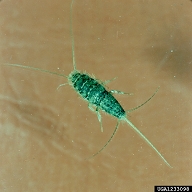Ixodes Ricinus - Ticks
 |
| Source:database.portal.modwest.com |
 |
| The Desert Cockroach Source: bugguide.net |
The Desert Cockroach, Arenivaga Investigata
This cockroach absorbs water vapor from the unsaturated atmosphere. It has two bladder-like extensions in its mouth-parts that are assumed to accomplish vapor absorption and vapor condensation to liquid form - a form that the cockroach needs for survival.
Firebrat, Thermobia Domestica
 |
| Firebrat Source: www.forestryimages.org |
The Mealworm Tenebrio molitor
 |
| mealworm Tenebrio molitor Source: http://www.ozanimals.com/Insect |
Soil-Dwelling Anthropods
 |
| SnowBug Source: http://soils.usda.gov |
Arthropods balance their water budget by actively absorbing water from highly unsaturated atmospheres. This animal maintains its body fluids hyperosmotic to its surroundings so that net water uptake occurs by passive diffusion along the gradient of water potential. The animal's basically manges glucose and myoinositol to effect large increases in osmotic pressure. This allows it to stay active in the same ranges of drought intensity like plants are capable of surviving.
The above creatures are but a handful of nature's creations that live off water vapor in the atmosphere using a specialized "condensation sac" and/or managing naturally occurring sugars (glucose) and materials synthesized from sugar e.g. myoinositol.
Do the above creations of nature hold the keys that we can use to guide our development of artificial machines that extract water vapor from the atmosphere?
No comments:
Post a Comment